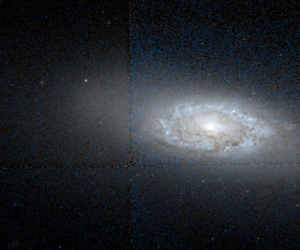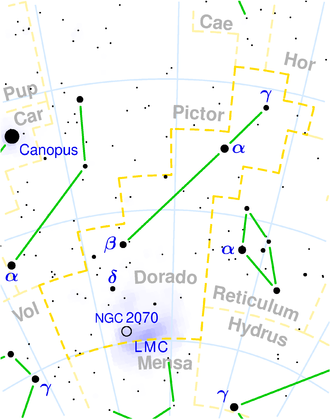NGC 1581
| Galaxy NGC 1581 |
|
|---|---|

|
|
| Photo from the Hubble Space Telescope | |
| AladinLite | |
| Constellation | Swordfish |
|
Position equinox : J2000.0 , epoch : J2000.0 |
|
| Right ascension | 04 h 24 m 44.9 s |
| declination | -54 ° 56 ′ 31 ″ |
| Appearance | |
| Morphological type | S0- |
| Brightness (visual) | 12.5 mag |
| Brightness (B-band) | 13.5 likes |
| Angular expansion | 1.8 ′ × 0.7 ′ |
| Position angle | 80 ° |
| Surface brightness | 12.8 mag / arcmin² |
| Physical data | |
| Affiliation | LGG 114 |
| Redshift | 0.005337 ± 0.000090 |
| Radial velocity | (1600 ± 27) km / s |
|
Stroke distance v rad / H 0 |
(64 ± 5) · 10 6 ly (19.5 ± 1.4) Mpc |
| history | |
| discovery | John Herschel |
| Discovery date | December 5, 1834 |
| Catalog names | |
| NGC 1581 • PGC 15055 • ESO 157-G026 • IRAS 04236-5503 • 2MASX J04244496-5456312 • SGC 042339-5503.3 • GC 854 • h 2642 • LDCE 0328 NED013 | |
NGC 1581 is a lenticular galaxy of Hubble type S0 in the constellation swordfish on the southern sky , the 64 million light-years from an estimated Milky Way is removed.
The object was discovered by astronomer John Herschel in 1834 with his 18.7-inch Newtonian telescope .
